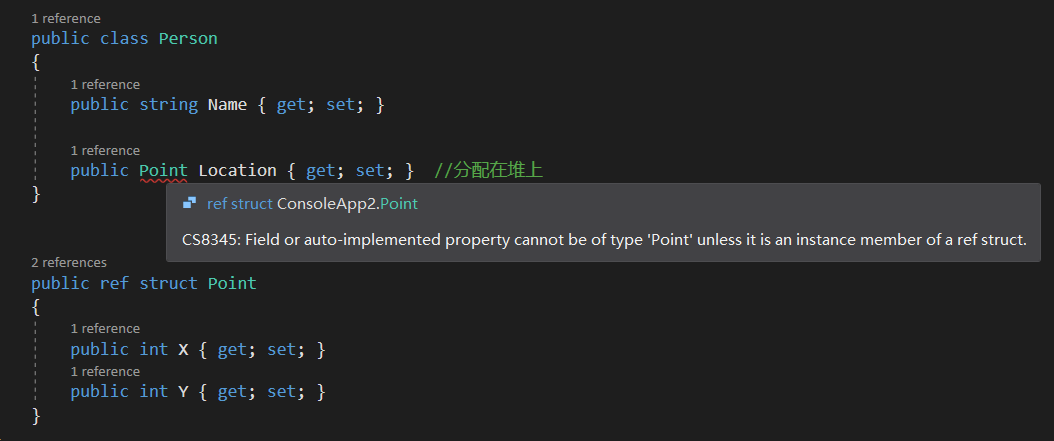一:背景
1. 讲故事
最近在翻 netcore 源码看,发现框架中有不少的代码都被 ref 给修饰了,我去,这还是我认识的 ref 吗?就拿 Span 来说,代码如下:
是不是到处都有 ref,在 struct 上有,在 local variable 也有,在 方法签名处 也有,在 方法调用处 也有,在 属性 上也有, 在 return处 也有,简直是应有尽有,太🐂👃啦,那这一篇我们就来聊聊这个奇葩的 ref。
二:ref 各场景下的代码解析
1. 动机
不知道大家有没有发现,在 C# 7.0 之后,语言团队对性能这一块真的是前所未有的重视,还专门为此出了各种类和底层支持,比如说 Span, Memory,ValueTask,还有本篇要介绍的ref。
在大家传统的认知中 ref 是用在方法参数上,用于给 值类型 做引用传值,一个是为了大家业务上需要多次原地修改的情况,二个是为了避免值类型的copy引发的性能开销,不知道是哪一位大神脑洞大开,将 ref 应用在你所知道的代码各处,最终目的都是尽可能的提升性能。
2. ref struct 分析
从小就被教育 值类型分配在栈上,引用类型是在堆上,这话也是有问题的,因为值类型也可以分配在堆上,比如下面代码的 Location。
其实这也是很多新手朋友学习值类型疑惑的地方,可以用 windbg 到托管堆找一下 Person 问问看,如下代码:
上面代码最后一行 00000014`0000000a 中的 14 和 a 就是 y 和 x 的值,稳稳当当的存放在堆中,如果你还不信就看看 gc 0代堆的范围。
从最后一行可看出,刚才的 0000010e368aadc8 确实是在 0 代堆 0x0000010E368A1030 - 0000010E368B55F8 的范围内。
接下来的问题就是能不能给 struct 做一个限制,就像泛型约束一样,不准 struct 分配在堆上,有没有办法呢?办法就是加一个 ref 限定即可,如下图:
 图片
图片
从错误提示中可以看出,有意让 struct 分配到堆上的操作都是严格禁止的,要想过编译器只能将 class person 改成 ref struct person,也就是文章开头 Span 和 this[int index] 这样,动机可想而知,一切都是为了性能。
3. ref method 分析
给方法的参数传引用地址,我想很多朋友都已经轻车熟路了,比如下面这样:
现在大家可以试着跳出思维定势,既然可以往方法内仍 引用地址 ,那能不能往方法外抛 引用地址 呢?如果这也能实现就比较有意思了,我可以对集合内的某一些数据进行引用地址返回,在方法外照样可以修改这些返回值,毕竟传来传去都是引用地址,如下代码所示:
 图片
图片
可以看到,数组的最后一个值已经由 30 -> 50 了,有些朋友可能会比较惊讶,这到底是怎么玩的,不用想就是引用地址到处漂,不信的话,看看 IL 代码咯。
可以看到,到处都是 & 取值运算符,更直观一点的话用 windbg 看一下。
上面代码处的 0x00000218c9aeadf0 就是 num 的引用地址,继续用 dp 看一下这个地址上的值为 16进制的32,也就是十进制的 50 哈。
三:总结
总的来说,netcore 就是在当初盛行的 云计算 和 虚拟化 时代诞生,基因和使命促使它必须要优化优化再优化,再小的蚂蚁也是肉,最后就是 C# 大法 🐂👃































